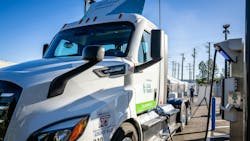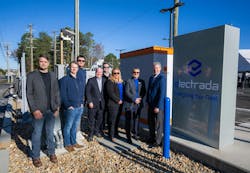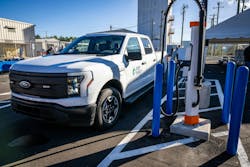Utility co. and CaaS provider open first-of-its-kind EV charging depot in the Southeast
The West Coast isn’t the only place in the U.S. where private companies and fleets have made strides to accelerate EV adoption. Two companies recently teamed up to build a first-of-its-kind electric vehicle charging depot and research center in North Carolina, with the capacity to charge vehicles on the grid, off the grid, and even with carbon-free electricity.
This site, developed by Duke Energy and Electrada, serves multiple purposes. Duke Energy, an electric utility provider serving states in the Southeast and Midwest, will use the facility to show fleets the possibilities of electrification and charging networks. For Electrada, a charging-as-a-service provider that helps fleets plan and execute charging infrastructure, the facility will enable vehicle electrification tests with different energy sources and chargers.
While it will act as a research and testing facility, its chargers are fully operational and will be used by Duke Energy fleet customers.
How this charging depot powers fleets
The research, testing, and charging depot, located in Mount Holly, North Carolina, features six charging stations, ranging from 120 to 300 kW. It also has two Level 2 chargers and the battery storage necessary to operate off the grid.
What allows it to generate carbon-free electricity are the multiple streams of electricity generation and the microgrid housed on the Duke Energy-owned site it established 10 years ago.
“This Duke Energy site ... had all of these renewable options there,” Zach Kuznar, managing director of grid solutions development for Duke Energy, told FleetOwner. “It had solar, it had all sorts of battery storage. We had hydrogen generation. We have natural gas [generator sets]; and so, we had all this infrastructure, and we have the ability to island from the grid. At the same time, we know we've got customers that want to electrify their fleets, but there wasn't something that really was a great demonstration for them to come see.”
What better way to showcase EV charging options to fleets than with a facility that already has the capabilities to generate electricity in this many ways? That’s where the partnership with Electrada began.
The partnership allowed Duke Energy “to put together a project where we're able to pair it with the renewables that have the ability to charge from carbon-free energy, but then it can also tie into the bulk electric system ... But then, it's also an operational depot for certain customers.”
Electrada also saw potential in the collaboration. The project has “a true R&D technology validation, but also a commercial service aspect to it,” Kevin Kushman, Electrada CEO, told FleetOwner.
Kushman believes this commercial service aspect will come into play with the first fleet customer who will use the depot, Salem Leasing, which manages Daimler Truck North America’s inbound operations in the Carolinas.
The launch of the microgrid, coupled with Salem’s use of the depot, is a great way to show customers that they can change the “energy stack” that serves EV chargers and discuss the cost implications of doing so. This site will show fleets that they can charge their vehicles away from the grid using solar power with battery storage or other renewable energy sources, as well as both on and off the grid. Essentially, the site will showcase “what’s electrically possible,” Kushman said.
This showcase is targeted toward potential or current fleet customers of both Electrada and Duke Energy who are faced with a "hodgepodge of potential ways to serve their electrification load,” Kushman explained. With this partnership, these customers will see how Electrada and Duke Energy address solutions together with a real customer charging their electric trucks to make real deliveries.
See also: What are EV truck charging stations’ needs?
It takes a partnership to create charging infrastructure
FleetOwner covered multiple depot openings, both public and private, in 2024. Because of the nuances of the fleet industry, regional electric grid capabilities, funding, and time constraints, no two depots are the same. However, they each have a critical aspect in common: partnership.
Building a private charging depot requires collaboration from the fleet, the utility, and often a third party—like Electrada—to facilitate the process. Building a public charging depot requires collaboration between the utility, the site owner, a charging-as-a-service provider, or other third party, and a commitment from area fleets to use the depot once it’s operational.
How utility companies plan for electrification
Electrifying a fleet can put a significant load on the electrical grid, and the utility’s primary roles in fleet electrification are “maintaining the infrastructure” and “getting the electrons to these sites,” Kuznar explained. This requires the utility to build out infrastructure upgrades or even develop other solutions to power depot locations.
Kuznar breaks it down further: Essentially, the fleet would notify their utility provider of their plans to electrify. Once it’s established how much power is needed to charge the fleet’s vehicles, it’s up to the utility to determine whether it can support those needs or if upgrades are necessary.
Then, there are other ways a utility supports a fleet’s electrification, and Kuznar said that’s through alternative power generation options. For example, a customer might prefer to charge their electric vehicles with fuel cells or by solar power with battery storage, Kuznar explained.
At times when upgrades are needed but require more time than is available—such as when the fleet or utility must acquire more land or build out more infrastructure—the utility might also provide temporary solutions that can get a fleet’s EV charging operational within a shorter time frame.
In those cases, the utility might offer a solution that acts as a “bridge, where we could have some sort of on-site generation or battery storage,” that allows the fleet to charge their EVs while the utility works on system upgrades, he said.
See also: What it takes to build charging infrastructure, according to a utility provider
Why fleets need an advocate in their electrification plans
Kushman refers to his business as a fleet advocate. As a fleet advocate, it’s important that Electrada understands the fleet’s needs and desires with its electrification plans.
“We have to understand what the duty cycle of the fleet is, what the vehicle types are, how often they'll be used, what time of day they'll be on the road versus back charging at the depot,” Kushman explained.
Once Electrada has a deep understanding of the fleet’s needs, its team will create a “load shape” for that business case. These load shapes often differ from fleet to fleet or even location to location, Kushman said.
“We present [the load shape] to the customer as: ‘Here’s what the infrastructure requirements are; we’re happy to invest in that infrastructure on your behalf and essentially provide you with electric fuel,’” he said.
After this point, Electrada will begin working with both the fleet and the utility, offering the utility a 24/7 power-use case to help it determine if grid upgrades are required.
“We really want this to be a bilateral conversation between Electrada acting as the customer's advocate and the utility, working to serve that requirement at the lowest cost of capital possible, so it's not burdening Duke's ratepayers with unnecessary costs, and it's not adding additional capital to the customer's use case that they don't need,” Kushman explained.
See also: Trucking industry struggles with new emissions-reducing regulations and EV challenges
Moving from conservation to ROI
Electrification has been a struggle—or even a pipe dream—for some fleets due to its complications, the multiple parties involved, and its hefty price tag. Even fleets that have piloted EVs in their operations are finding it difficult to scale, Kushman said. What’s more, the conversation around fleet electrification has shifted. The conversations Kushman has had with prospective customers have become less about environmental, social, and governance goals, and the focus has shifted instead to “sustainability with an ROI.”
“Throwing money at [emissions reductions] opportunities and hoping that you get an incentive or a grant or some sort of offset to help pay for it and make it ROI neutral—the blinders are off in that sense,” Kushman told FleetOwner.
Fleet electrification now must become closer in parity with operating vehicles powered by internal combustion engines. Kushman said his customers have already “DIY-ed” EV pilots, and they’re coming to Electrada saying “’Help us make the case to scale to our executive management,’ and that all has to be based on cost,’” Kushman said.
About the Author
Jade Brasher
Senior Editor Jade Brasher has covered vocational trucking and fleets since 2018. A graduate of The University of Alabama with a degree in journalism, Jade enjoys telling stories about the people behind the wheel and the intricate processes of the ever-evolving trucking industry.



